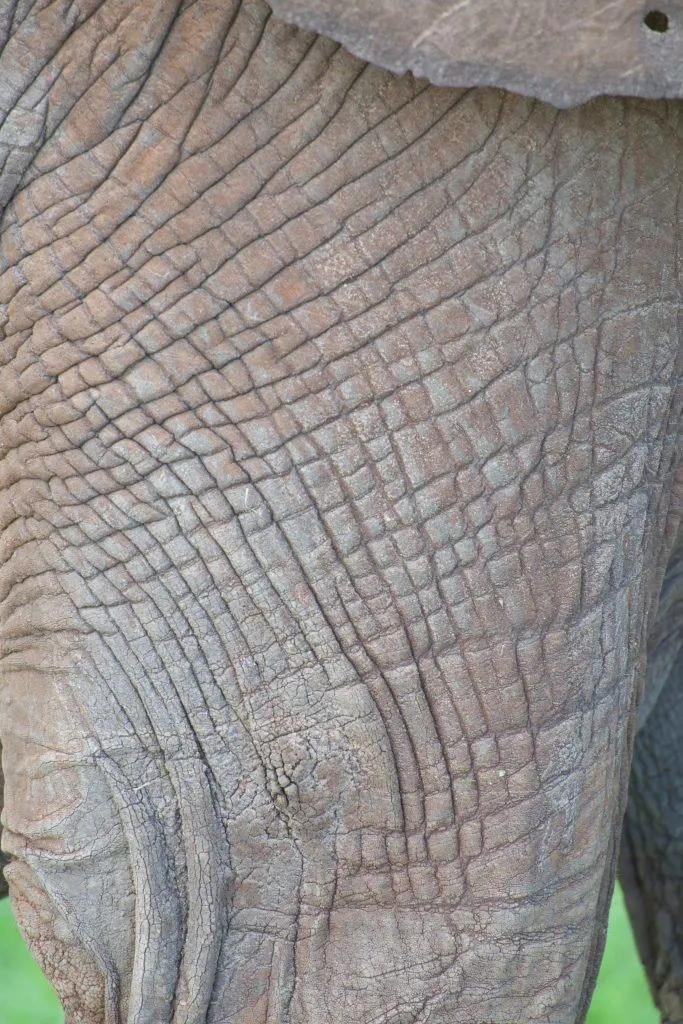How African Elephants Get Their Wrinkles
The animal’s crevice-filled skin helps keep it cool and shares a surprising set of similarities with the human skin disease ichthyosis vulgaris
/https://tf-cmsv2-smithsonianmag-media.s3.amazonaws.com/filer/b6/9d/b69d3858-e556-42eb-a242-a009b7c86abf/5bb31735932a0.jpg)
The African bush elephants’ wrinkled skin is one of its most defining characteristics. The purpose of this patchwork pattern—it helps the animal stay cool by retaining moisture better than smooth skin—is well-known in the scientific community, but the secrets of its formation have eluded researchers.
Now, a study published in Nature Communications offers a surprising explanation for the emergence of elephants’ crevice-filled skin: As Roni Dengler reports for Discover, the mammals’ skin thickens over time, with new layers placing pressure on the outermost sheet (the stratum corneum), leaving a web of cracks on the surface.
Initially, researchers assumed that elephant skin fractured in a manner similar to that seen in dry mud or damaged asphalt. A 2013 study conducted by the new study's co-author Michel Milinkovitch, a University of Geneva evolutionary biologist and biophysicist, found that tensiles stress, or a process of shrinking, was responsible for producing the scaly folds seen on crocodiles’ skin.
Building on his previous work, Milinkovitch and his colleagues took CT scans of elephant skin samples and created a computer model that simulated skin growth in order to gauge similarities between crocodiles and elephants. The team expected to see shrinkage, but as CNN’s Ashley Strickland notes, that alone couldn't be the sole answer. The layers actually appeared to bend, generating a network of “microvalleys” on the stratum corneum.
“It is very counterintuitive that cracking the skin could be beneficial," Milinkovitch tells Strickland.
Given the African elephant’s unusual physiology, however, the scientists’ findings make sense. Newsweek’s Aristos Georgiou writes that the creatures lack the sweat and sebum glands most mammals rely on to keep cool. Instead, overheated elephants must splash around in a pool of water or mud. Thanks to their intricately cracked skin, they end up retaining five to 10 times more moisture than a smooth surface. As this trapped liquid evaporates, it enables elephants to regulate their body temperature and prevent dehydration. Mud stuck to the skin also helps the animals ward off parasites.

According to a press release, the cracking process evident in elephant development is more typical of non-living materials. Whereas the elephant’s epidermis physically cracks due to the pressure of skin layers bending, most biological systems’ cracked appearances are the product of tightly folded layers of tissue.
Elephants’ singular skin actually has a lot in common with those of humans suffering from the skin disease ichthyosis vulgaris. This condition affects one out of every 250 people, Douglas Quenqua reports for The New York Times, and prevents the shedding of dead skin cells. The disease, which has no cure but is often treated with moisturizers, renders the skin dry, thick and scaly.
Although this condition poses an obvious disturbance to humans, it’s highly beneficial for African elephants. As skin cells pile up, they exert enough pressure to bend the outer layer, creating the network of rivulets that helps them stay cool.
“If the skin was shedding, it would never get thick enough to generate the stress inside the little valleys of this lattice of elevations, and you would not have the cracks appearing,” Milinkovitch tells Quenqua. “In humans, this is not a helpful problem.”
Additional research must be conducted to confirm the link between elephant skin shedding and ichthyosis vulgaris, but as CNN’s Strickland notes, such verification would provide a unique example of how a harmful human mutation is a powerful adaptation in another species. It’s also possible that further study could yield a way of treating the condition in humans.
Milinkovitch’s next step will be observing the growth of a newborn African elephant.
“We would like to follow the cracking on the skin of a baby African elephant to understand the dynamic of the process," he tells CNN. "Are the cracks appearing everywhere or do they appear in a specific place and then propagate? Does it take ... weeks or does it take six months? It's a new, beautiful example of how physical processes are involved in the development of animal forms and shapes."
/https://tf-cmsv2-smithsonianmag-media.s3.amazonaws.com/accounts/headshot/mellon.png)
/https://tf-cmsv2-smithsonianmag-media.s3.amazonaws.com/accounts/headshot/mellon.png)